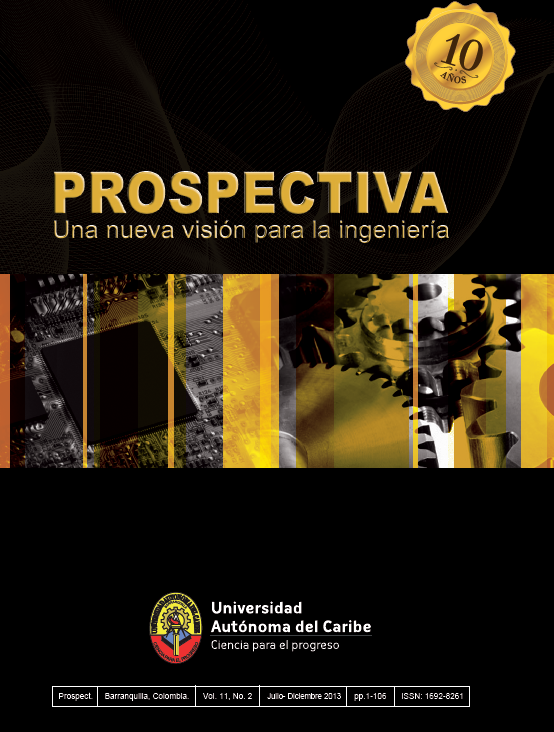Design of a mechanical subcooling system device for increasing a low temperature refrigeration system’s capacity
DOI:
https://doi.org/10.15665/rp.v11i2.33Palabras clave:
Subenfriamiento mecánico, COP, temperatura de subenfriamiento, efectividad.Resumen
El subenfriamiento mecánico se emplea para incrementar el coeficiente de desempeño de cualquier ciclo de refrigeración,
especialmente en las aplicaciones de baja temperatura. Cuando es necesario reconfigurar un ciclo
existente, un dispositivo de subenfriamiento mecánico permite una gran flexibilidad para encontrar un punto
específico de operación, ya sea un sistema combinado con un mejor coeficiente de desempeño (COP) y una mayor
capacidad de refrigeración o un sistema combinado de la misma capacidad que trabaja por menos tiempo y un
mejor COP. Las simulaciones corridas en Aspen HYSYS® permiten estudiar tantos casos posibles como pueden
presentarse para lograr un diseño óptimo en el sistema reconfigurado, teniendo en cuenta la restricciones que
representan cada uno de los componentes existentes en el sistema principal.
Citas
Thornton,J.W., Klein,S.A., and Mitchell,J.W. Dedicated mechanical subcoolingdesign strategies for supermarket
applications. Int. J.Refrig., 17(8), 508- 515,1994.
Khan,J.R.and Zubair,S.M.Design and rating of dedicated mechanicalsubcoolingvapour-compression system.
Proc. Inst. Mech. Eng.,214, 455-471, 2000.
. Khan, J-ur-R.andZubair,S.M. Design and rating of an integrated mechanical-subcooling vapor-compression
refrigeration system.Energy Convers.Manage., 41, 1201- 1222,2000.
Qureshi,B.A. andZubair,S.M. The effect of refrigerant combinations on performance of a vapor compression refrigeration
system with dedicated mechanical sub-cooling. Int. J.Refrig.,35, 47-57, 2012.
Ding, G.L.Recent developments in simulation techniques for vapour-compression refrigeration systems.
Int.J.Refrig., 30, 1119-1133, 2007.
. Benouali, J.,Young, S. and Clodic, D. Analysis of the sub-cooling on refrigerating systemsusing R-410A OR R-
A. Eighth International Refrigeration Conference, Purdue University, West Lafayette, USA, 2000.
Kyoto Protocol, Report of the Conference of the Parties.United Nations Framework Convention on Climate
Change (UNFCCC) Kyoto, Japan, 1997.
Calm, J.M. Emissions and environmental impacts from airconditioningand refrigeration systems. Int. J. Refrig. 25,
-305, 2002.
Sand, J.R., Fischer, S.K., and Baxter, V.D., TEWI analysis: its utility, its short comings, and its results.
In:International Conference on Atmospheric Protection-Taipei, Taiwan. 1999.
Schwarz, W. Emission of Refrigerant R-134a from Mobile Air- Conditioning Systems. Study conducted for the German Federal EnvironmentOffice,(Internet). Disponible desde: http://www.umweltbundesamt.de/sites/default/
files/medien/publikation/long/3110.pdf, [Acceso 15octubre 2013].
Cengel, Y. A. and Boles, M. A. Thermodynamics: an engineering approach, 7th edn. McGraw-Hill, New York,
GEA FlatPlate SELECT- ONLINE. (Internet) On line from: http://flatplateselect.com/site/hx/chooseapp.aspx .
[Access January 7th 2013].
Emerson Climate Technologies. (Internet) On line from: http://www.emersonclimate.com/enUS/products/
condensing_units/Pages/condensing_units.aspx. [Access January 7th 2013].
Danfoss. (2010). Technical brochure, Thermostatic expansion valves TUA/TUAE. (Internet). On line from:
http://www.ra.danfoss.com/TechnicalInfo/Literature/ Manuals/01/DKRCCPDAG0A302.pdf. [Access October 17th 2013].
Trott, A.R., Welch, T.C. Refrigeration and Air- Conditioning,third ed. Butterworth-Heinemann, UK, 2000.
Descargas
Número
Sección
Licencia
Los autores/as que publiquen en esta revista aceptan las siguientes condiciones:
- Los autores/as ceden los derechos de autor y dan a la revista el derecho de la primera publicación, con el trabajo registrado con la licencia de atribución de Creative Commons, que permite a terceros utilizar lo publicado siempre que mencionen la autoría del trabajo y a la primera publicación en esta revista.
- Los autores/as pueden realizar otros acuerdos contractuales independientes y adicionales para la distribución no exclusiva de la versión del artículo publicado en esta revista (p. ej., incluirlo en un repositorio institucional o publicarlo en un libro) siempre que indiquen claramente que el trabajo se publicó por primera vez en esta revista.
- Se permite y recomienda a los autores/as a publicar su trabajo en Internet (por ejemplo en páginas institucionales o personales) antes y durante el proceso de revisión y publicación, ya que puede conducir a intercambios productivos y a una mayor y más rápida difusión del trabajo publicado (vea The Effect of Open Access).
Instrucciones para el llenado de la Certificación de Originalidad y la Cesión de Derechos de Autor.
- Haga click aquí y baje el formulario de Certificación de Originalidad y la Cesión de Derechos de Autor.
- En cada uno de los campos para rellenar haga click y complete lo correspondiente.
- Una vez llenos los campos, copie al final su firma escaneada o firma digital. Favor ajustar el tamaño de la firma en el formulario.
- Finalmente, lo puede guardar como pdf y enviarlo a través de la palataforma OJS, como archivo complementario.
Si tiene dudas contáctenos, por favor.


